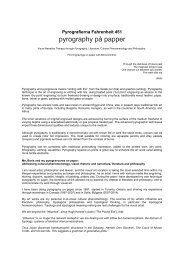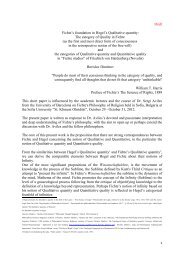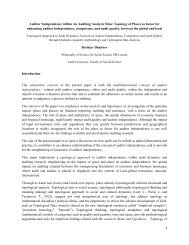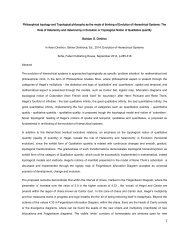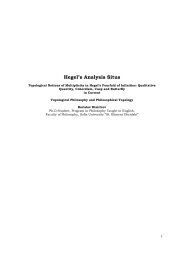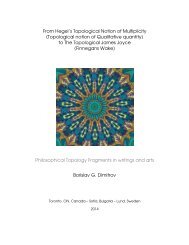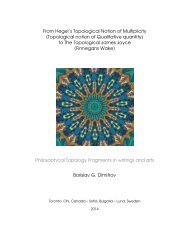Topological Ontology and Logic of Qualitative quantity
Qualitative quantity and BFO (Basic Formal Ontology) of /Barry Smith/ and YAMATO (Yet Another More Advanced Top-level Ontology) of /Riichiro Mizoguchi/
Qualitative quantity and BFO (Basic Formal Ontology) of /Barry Smith/ and YAMATO (Yet Another More Advanced Top-level Ontology) of /Riichiro Mizoguchi/
- No tags were found...
You also want an ePaper? Increase the reach of your titles
YUMPU automatically turns print PDFs into web optimized ePapers that Google loves.
The link between <strong>Qualitative</strong> <strong>quantity</strong> <strong>and</strong> Topology (in particular <strong>Topological</strong> Data<br />
Analysis), <strong>and</strong> the proposition <strong>of</strong> the <strong>Qualitative</strong> <strong>quantity</strong> method as tool for the <strong>Topological</strong><br />
Data Analisys, is encouraged by Richiro Mizoguchi’s interpretation <strong>of</strong>fered in part “3.<br />
Quality <strong>and</strong> Quantity, 3.1 Background” from his “YAMATO : Yet Another More Advanced<br />
Top-level <strong>Ontology</strong>” – “e-Science needs data exchange world-wide. Especially, in biology<br />
<strong>and</strong> bio-informatics, data exchange has been intensively conducted through global<br />
collaboration in the daily activities. In order to make it smooth to exchange scientific data,<br />
the way <strong>of</strong> description must be compatible with each other. Description <strong>of</strong> data/objects is<br />
usually done by determining attribute values. However, quality description is not wellunderstood<br />
by practitioners. Even pr<strong>of</strong>essionals seem not to agree on the common way <strong>of</strong><br />
quality description <strong>of</strong> objects.” 38<br />
According to Riichiro Mizoguchi, “There are at least three ways <strong>of</strong> quality description<br />
recommended by BFO, DOLCE <strong>and</strong> Galen(Alan 2010). BFO recommends <br />
(e.g., ) formalism, while DOLCE (e.g., ) <strong>and</strong> Galen (e.g., 5). The problem<br />
is two fold: (a) one way <strong>of</strong> representation is not enough for real world problems because<br />
there exist multiple kinds <strong>of</strong> quality descriptions in the real data <strong>and</strong> (b) there is no explicit<br />
model <strong>of</strong> how these three are different from <strong>and</strong> interrelated with each other. The ontology<br />
<strong>of</strong> Quality <strong>and</strong> Quantity in YAMATO tries to give fundamental conceptualization <strong>of</strong> those<br />
existing descriptions in one ontology. To do so, YAMATO distinguishes between quality in<br />
reality <strong>and</strong> quality description <strong>and</strong> has a type hierarchy which reflects existing notions<br />
used in quality descriptions.”<br />
Investigating “the underlying philosophy” <strong>of</strong> Quality, in part “3.2 Quality -<br />
3.2.1 The underlying philosophy”, Riichiro Mizoguchi establishes that “one <strong>of</strong> the<br />
contributions <strong>of</strong> our ideas is clear distinction between attribute <strong>and</strong> attribute values. As far<br />
as I know, there are three dependent entities related to the term attribute: (1) attribute as a<br />
type that plays as dimension, (2) attribute as an instance <strong>and</strong> (3) attribute value that might<br />
correspond to <strong>quantity</strong>. However, some ontologies do not distinguish between (2) <strong>and</strong> (3).<br />
In this respect, DOLCE nicely differentiates instance <strong>of</strong> attribute from attribute value by<br />
introducing quality for attribute as an instance <strong>and</strong> quale/qualia for attribute value. This<br />
38<br />
Riichiro Mizoguchi, “YAMATO : Yet Another More Advanced Top-level <strong>Ontology</strong>”, pp.3-4:<br />
http://www.ei.sanken.osaka-u.ac.jp/hozo/onto_library/YAMATO101216.pdf<br />
18





